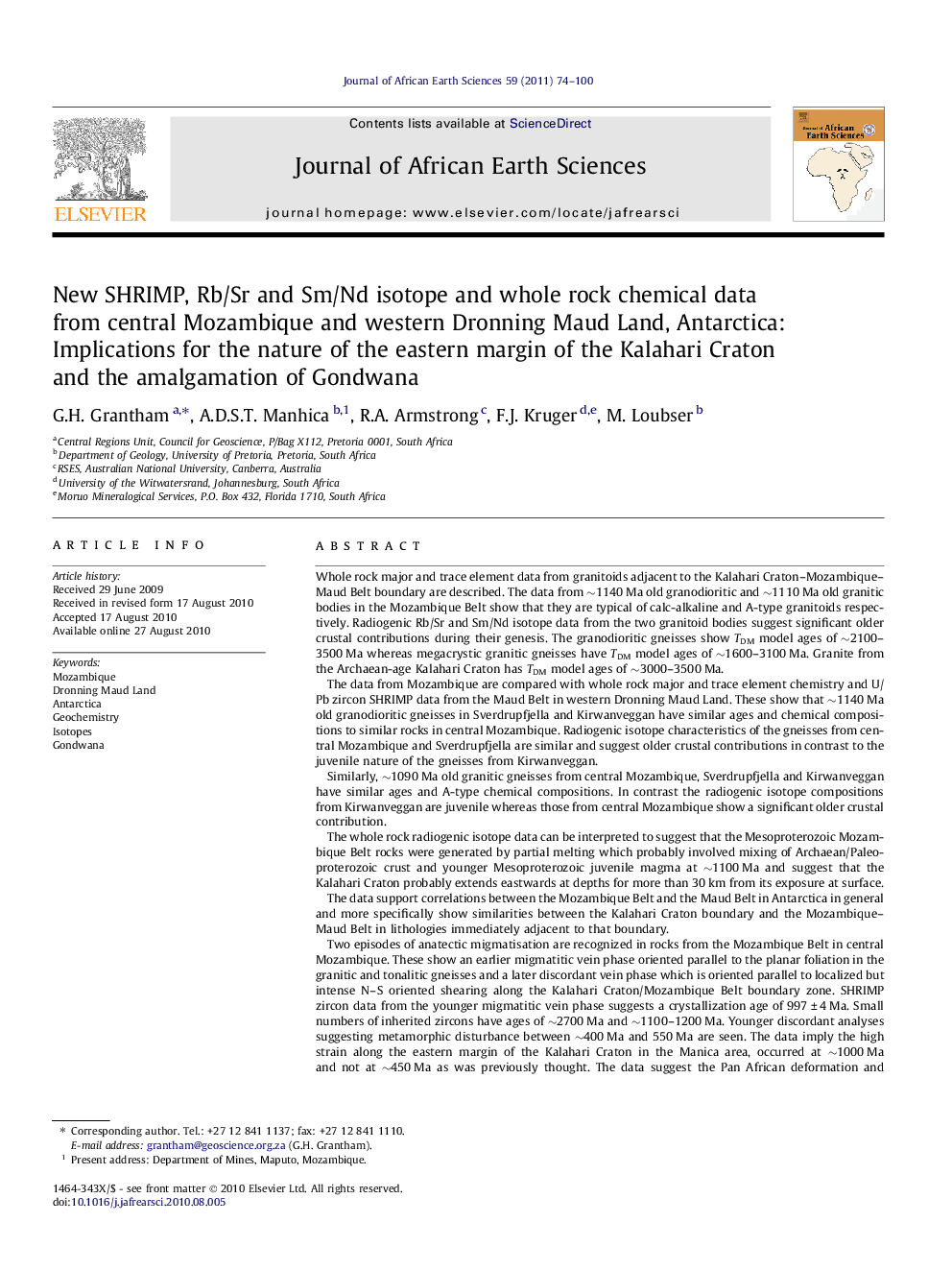| کد مقاله | کد نشریه | سال انتشار | مقاله انگلیسی | نسخه تمام متن |
|---|---|---|---|---|
| 4729199 | 1356511 | 2011 | 27 صفحه PDF | دانلود رایگان |

Whole rock major and trace element data from granitoids adjacent to the Kalahari Craton–Mozambique–Maud Belt boundary are described. The data from ∼1140 Ma old granodioritic and ∼1110 Ma old granitic bodies in the Mozambique Belt show that they are typical of calc-alkaline and A-type granitoids respectively. Radiogenic Rb/Sr and Sm/Nd isotope data from the two granitoid bodies suggest significant older crustal contributions during their genesis. The granodioritic gneisses show TDM model ages of ∼2100–3500 Ma whereas megacrystic granitic gneisses have TDM model ages of ∼1600–3100 Ma. Granite from the Archaean-age Kalahari Craton has TDM model ages of ∼3000–3500 Ma.The data from Mozambique are compared with whole rock major and trace element chemistry and U/Pb zircon SHRIMP data from the Maud Belt in western Dronning Maud Land. These show that ∼1140 Ma old granodioritic gneisses in Sverdrupfjella and Kirwanveggan have similar ages and chemical compositions to similar rocks in central Mozambique. Radiogenic isotope characteristics of the gneisses from central Mozambique and Sverdrupfjella are similar and suggest older crustal contributions in contrast to the juvenile nature of the gneisses from Kirwanveggan.Similarly, ∼1090 Ma old granitic gneisses from central Mozambique, Sverdrupfjella and Kirwanveggan have similar ages and A-type chemical compositions. In contrast the radiogenic isotope compositions from Kirwanveggan are juvenile whereas those from central Mozambique show a significant older crustal contribution.The whole rock radiogenic isotope data can be interpreted to suggest that the Mesoproterozoic Mozambique Belt rocks were generated by partial melting which probably involved mixing of Archaean/Paleoproterozoic crust and younger Mesoproterozoic juvenile magma at ∼1100 Ma and suggest that the Kalahari Craton probably extends eastwards at depths for more than 30 km from its exposure at surface.The data support correlations between the Mozambique Belt and the Maud Belt in Antarctica in general and more specifically show similarities between the Kalahari Craton boundary and the Mozambique–Maud Belt in lithologies immediately adjacent to that boundary.Two episodes of anatectic migmatisation are recognized in rocks from the Mozambique Belt in central Mozambique. These show an earlier migmatitic vein phase oriented parallel to the planar foliation in the granitic and tonalitic gneisses and a later discordant vein phase which is oriented parallel to localized but intense N–S oriented shearing along the Kalahari Craton/Mozambique Belt boundary zone. SHRIMP zircon data from the younger migmatitic vein phase suggests a crystallization age of 997 ± 4 Ma. Small numbers of inherited zircons have ages of ∼2700 Ma and ∼1100–1200 Ma. Younger discordant analyses suggesting metamorphic disturbance between ∼400 Ma and 550 Ma are seen. The data imply the high strain along the eastern margin of the Kalahari Craton in the Manica area, occurred at ∼1000 Ma and not at ∼450 Ma as was previously thought. The data suggest the Pan African deformation and metamorphism in the area involved minor reworking. The undeformed to weakly deformed Tchinadzandze Granodiorite intruded into the Kalahari Craton has an age of 2617 ± 16 Ma.
Research highlights
► Lithological units with similar chemistry and age from Mozambique and Maud Belts close to the Kalahari Craton boundary.
► Kalahari Craton probably continues at depth to the east of the craton boundary.
► New U/Pb SHRIMP zircon data from migmatitic veins suggest dominant deformation along the Kalahari Craton edge of Mesoproterozoic age in contrast to previously reported Pan Africa ages.
Journal: Journal of African Earth Sciences - Volume 59, Issue 1, January 2011, Pages 74–100